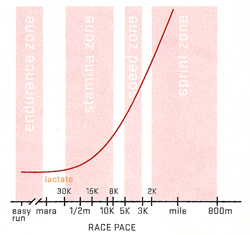Let's continue our 3 part look at what makes a good runner. Here is a link to Max2part 1 on VO, in case you missed it.
In part 2 we'll explain lactate threshold. A body’s lactate threshold is the point of exercise at which lactate and hydrogen ions, the by-products of the production of energy, accumulate faster than you can metabolize and get rid of them. When lactate and hydrogen ions build up, muscle fatigue ensues and exercise capacity drops. Lactate threshold is usually reached at higher intensity exercise, where anaerobic energy production increases. Once a runner reaches lactate threshold, their ability to sustain the level of exercise decreases and they have to back off.
By training lactate threshold, the body becomes more efficient at producing energy and eliminating or buffering the lactate and hydrogen ions. Therefore, the runner can sustain a higher state of exercise intensity for longer.
Training lactate threshold involves runs at moderate to high intensity. This correlates to exertion levels around75-85% of VO2max or a rating of perceived exertion (RPE) of “hard.” For most runners, this will coincide with a typical 10k pace.
Intervals are a great way to train lactate threshold. Traditional “tempo” intervals are usually involve running 1200m to a mile at a fixed pace (10k pace) with 1-2 minute recovery time in between each interval. Some researchers have found that doing variable-pace intervals has more benefit than set-pace intervals for training lactate threshold. Examples of variable-pace intervals include the following:
- 800m repeats: 6-7 x 800m repeats at lactate pace with 1-2 min of recovery between each repeat.
- 3 x 400/1200m compound sets:
- Run 400m at just above VO2 pace. With no recovery, slow down to lactate pace for 1200m.
- Recover with 2 minutes rest. Repeat 4 more times for a total of 5 compound sets.
- 2-3 x 200/1600/200m compound sets:
- Run 200m at VO2 pace, then slow to lactate pace for 2000m (1 1/4 miles).
- Finish the set by kicking back up to VO2 pace for the last 200m.
- Recover 3 minutes between each compound set.
- 2 x 12min with 4 min recovery
- 2 x 5 min with 5 min recovery
If you are interested in learning more about VO2 or lactate threshold information or are interested in being tested contact our Bountiful Running Lab for details.
